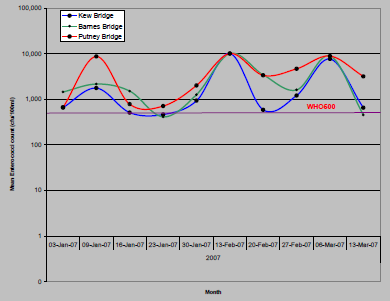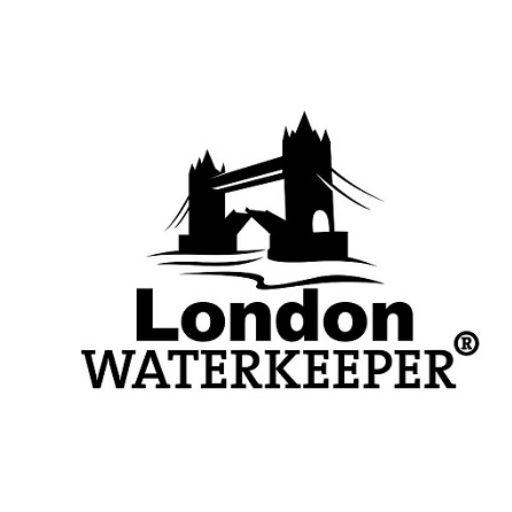The sections below refer to the City of London’s suggestions for displaying information for the public on the water quality in the Thames. The full report is no longer online. Despite being in 2007 it is the most recent, comprehensive study into the water quality of the Thames with regards to recreational use.
Introduction
Safe and attractive recreational water environments on the Thames are a valuable resource to Londoners and visitors; however those responsible for public health have a duty of care to ensure that recreational use of the river is not detrimental to health. Within the EU, agencies responsible for river quality require timely information on the risk of illness to users based on of measures of water quality. Since health risk is likely to vary to some degree by time and place, informed estimates of risk to the health of users will be desirable to inform policy, and for safe management of such major inland waters and their catchments used for recreational purposes.
Information for recreational users of the tideway
The City of London with input from the Health Protection Agency are responsible for water quality with regards to recreational use on the tideway, and require timely information on the risk of illness, if any, to users of these waters. The data accrued in this study provide the potential for the development of a public information system to adequately inform the public of risks associated with tideway usage in a timely manner. Predictive models of microbiological parameters, particularly enterococci and E. coli using the time since the last local CSO discharge event, indicate that levels of these indicators can be predicted with an acceptable level of accuracy given timely information about discharge events. The accuracy of such predictive models will be improved with increased numbers of monitored events against which microbiological parameters have been analysed. These predictions currently
remain, at best, “ball park” figures, but still provide an indication of the likely levels of
indicator organisms within the upper tideway reach, and as such, the potential associated health risk.
Formats for the provision of information to the public range from simple leaflets to the
provision of online web based reporting systems or electronic signage systems as adopted by the Scottish Environmental Protection Agency (www.sepa.org.uk) for beach water quality.
Increased monitoring of basic microbiological parameters would be required for both the latter of these options, and would also provide further data to enhance any predictive models. In addition to water quality monitoring, information would be required on tidal activity, rainfall and CSO discharge events. Such a system would to a great extent, be reliant on the timely exchange of accurate information between the Environment Agency, Thames Water and City of London.
The simplest and possibly most cost effective manner of making this information available to the recreational public would be through existing Internet facilities such as those of the City of London. The suggested format for such a web page would be the provision of frequently updated graphic images of the 95 percentile values for enterococci displayed over six months, with a higher temporal resolution for the previous month (Figure 24).

Figure 24. High temporal resolution representation of water quality data. An Example of graphical representation of higher resolution indicator organism counts stratified by
location to provide a picture of water quality in the past two months. This data is shown against the World Health Organisation guidance levels (500cfu/100ml) for interpretation purposes.
Such images would need the caveats associated with interpretation of the data against available water quality standards (World Health Organisation Guidelines for safe recreational water environments or the European Commission Bathing water Directive 2006/7/EC (Inland waters)).
The resources required to maintain such a reporting system need to account for sampling collection costs and time, and could be maintained using water quality monitoring of the primary indicator organisms E. coli and enterococci.
Provision of advice to users of the Thames tideway
The Health Protection Agency support The City of London as the local Authority for the tideway, in protecting the public health of users of the tideway, by issuing advice which is timely and related to the actual risks to users, particularly the more vulnerable groups such as children, the elderly and immuno-suppressed. Clearly some groups are more likely to become immersed in the tidal waters through both design and accident (canoeists and windsurfers), than others such as experienced rowers or commercial pleasure craft handlers.
Each group of activities will carry its own level of risk, based on a combination of the
likelihood of ingestion of water, age, health status and frequency of exposure to the waters.
Clear advice is required with regards to accessing the tideway and the tideway foreshore, both normally, and after excessive rainfall events. A simple “traffic light” system could be used.
The provision of the following simple advice is suggested:
• Users of the river are advised to ensure that they wash their hands and faces before consuming food and drink.
• To shower after total body immersion
• To avoid food and water consumption whilst on the water unless adequate protective measures have been taken to reduce the likelihood of cross contamination of the water/food container from river water.
• Avoid contact with sands silts and gravels without adequate protective wear such as
boots and gloves. This will also reduce the likelihood of receiving cuts from glass or
metal fragments in the gravel.
• Contact with tideway waters during and after stormy wet weather conditions represents a significant health risk to all users of the tideway. Users should try to avoid direct contact with the tideway waters for at least 3 days after stormy weather (preferably 4 days), to allow the tideway to self clean through the tidal ebb and flow.
• Hazards on the tideway are not only of microbiological, but may also be of chemical
origin. Storm water flows also increase the real likelihood of submerged debris causing hazards, from pleasure craft damage to causing obstructions to rowers resulting in accidental immersion.
• Cover or treat blisters, cuts, grazes and insect bites appropriately whilst on the river, and wash with a suitable antiseptic after leaving the water.
• Wash all equipment with detergent after leaving the water.
Future Research – Monitoring of microbiological parameters
The basis for a public information system exists in the data collected to date. Such a system needs to elucidate the reasoning behind the science, enabling the public and authorities using the tideway to make informed decisions on the relative health benefits and risks to users inherent in their chosen activity. Any system for risk assessment and management will be reliant on the timely provision of data from the Environment Agency, Thames Water and the continued microbiological monitoring at Kew Barnes and Putney. Continued monitoring of basic water quality parameters (indicator organisms) is advisable to both expand and improve the current dataset and knowledge. Future research needs include:
• Continued monitoring of basic water quality parameters (indicator organisms) which is advisable to both expand and improve the current dataset and knowledge. The different weather patterns and state of the tide have been shown to have a significant effect on the quality of river water. Continued monitoring will improve the ability to monitor trends with respect to differing weather conditions and assist in predicting poor water quality.
• A review of the relative contribution of Mogden STW to the upper reaches of the
tideway, by sampling between Kew and Isleworth, Isleworth and Richmond, and above Teddington lock. Samples from above Teddington lock are important to provide an indication of pollutant inputs in the Thames catchment area and therefore not
necessarily local to the tideway. Sampling from this area may provide some answers to the temporal incidence of specific Salmonella serotypes identified in the current study, which may not necessarily be linked to sewage outfalls but maybe for example related to agricultural practices.
• A collaborative project with the Health Protection Agency and the EA and possibly
others, using a current methods, for example Bacteroides bacteriophages selected for various specific animal and human host strains, molecular methods developed by the EA using specific animal and human markers for source tracking of faecal pollution to establish whether this is of human or animal origin. Investigations into the distribution and types of enteric viruses should also be included in the profiling of river pollution.
This data would help to determine whether the pollution source was all attributable to
sewage, particularly upstream of Teddington Lock, or if agricultural run off or unknown commercial activities (for example, abattoirs) has a significant influence.
